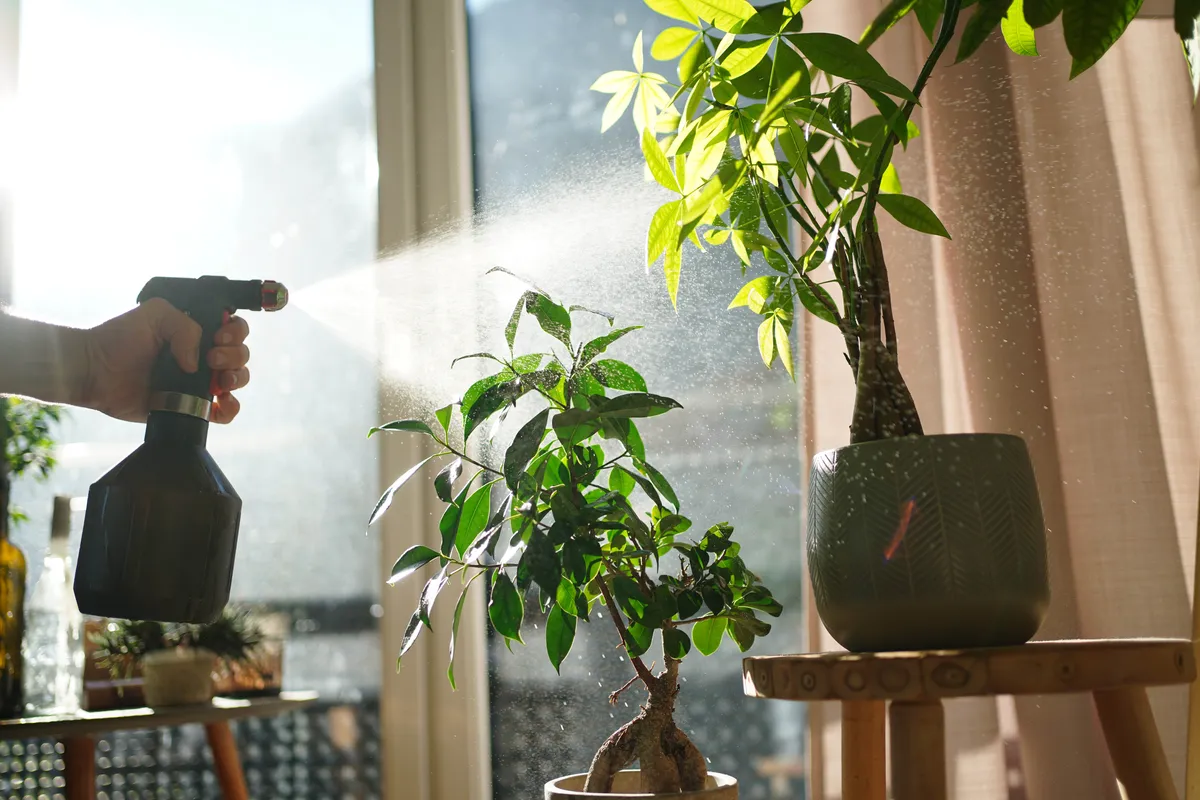House plant books and websites often advise us to mist our house plants to raise the humidity around them, avoiding the brown leaf tips and crispy leaves associated with dry air. But house plant experts are now saying that this technique has little positive effect on house plants.
Dr Stu Farrimond, author of The Science of Gardening, published in March 2023 by Dorling Kindersley, is of the opinion that misting plants is ineffective. In the book, he states: "Misting plants with water spray is a common way to raise humidity, although its effects are very shortlived: droplets settle on leaves and gradually evaporate, briefly increasing the humidity around them, before the moisture dissipates into the room. On dry winter days, water droplets may only linger for 10-15 minutes, meaning that hourly spraying would be needed to have any impact."
Misting a plant with a spray bottle is pretty pointless if you are doing it to increase humidity.
Sarah Gerrard-Jones
Sarah Gerrard-Jones, author of The Plant Rescuer, published by Bloomsbury in 2022, echoes Dr Stu's thoughts, and does not recommend misting in her book. She told us: "Misting a plant with a spray bottle is pretty pointless if you are doing it to increase humidity. It isn’t really a beneficial activity for your plants and may increase the risk of bacterial and fungal infection, particularly to hairy-leafed plants such as African violets and begonias, which are susceptible to powdery mildew and fungal bacteria caused by moisture on the leaves."
We also asked Guy Barter, chief horticulturalist at the RHS, for his opinion. He said: "When you mist a plant, the water vapour produced has a highly transient effect on humidity. Any water applied will swiftly evaporate, disperse as vapour and have limited effect."
It also appears that we do not need to worry about humidity levels in our homes anyway. Many house plants hail from rainforests, where humidity is very high, but this does not mean that they cannot cope with the lower humidity in our homes.
It appears that the traditional dish of damp pebbles, placed under a house plant to raise humidity around it, is pretty pointless
Guy Barter says: "Most UK homes are apparently at 40 per cent to 50 per cent relative humidity in most parts of the house, which is more or less what houseplants will be happy with. I would be surprised if the humidity in an average dwelling is very low – what with cooking, bathing, breathing and so on, excess condensation might be expected to be more common." Sarah Gerrard-Jones echoes this: "The level of humidity in my house isn't something I ever lose sleep over."
Guy advises: "House plants have been chosen to tolerate dry atmospheres, so it is wise to choose ones with notable tolerance where the air is especially dry, usually in warm rooms, such as Sansevieria. Another remedy is to open the window – not a great idea in winter but on warm days in other seasons, the outdoor air is much more humid than indoors." And of course, some humidity lovers, such as Adiantum raddianum, are perfect for a closed terrarium.

It appears that the traditional dish of damp pebbles, placed under a house plant to raise humidity around it, is pretty pointless, too. Dr Stu Farrimond says: "Pebble trays are frequently recommended to keep indoor plants happy. The theory goes that evaporation from a shallow tray or dish filled with water and pebbles will increase the humitidy in the air around plants standing on the pebbles. In reality, however, it does nothing to help the plant. The humid air just above the water doesn't rise straight up, but idffuses in all directions, meaning that the humidity at the height of a plant's roots and leaves is essentially unchanged. "
Sarah Gerrard Jones echoes this view, as does Guy Barter, who told us: "Wet surfaces such as pebbles will release water but it will swiftly disperse and have limited effect."
Guy also says that brown leaf tips or leaves, often thought to be a sign of low humidity, can have several other causes. "Excess temperature or draughts lead to more rapid water loss than can be replenished from the roots. So a cooler, less draughty room might be in order. Underwatering or indeed overwatering may also have occurred, where the airless roots will not efficiently pick up water."
So before you blame low humidity and reach for the spray bottle, check what else may be ailing your plants.
Read more on whether house plants can beat mould